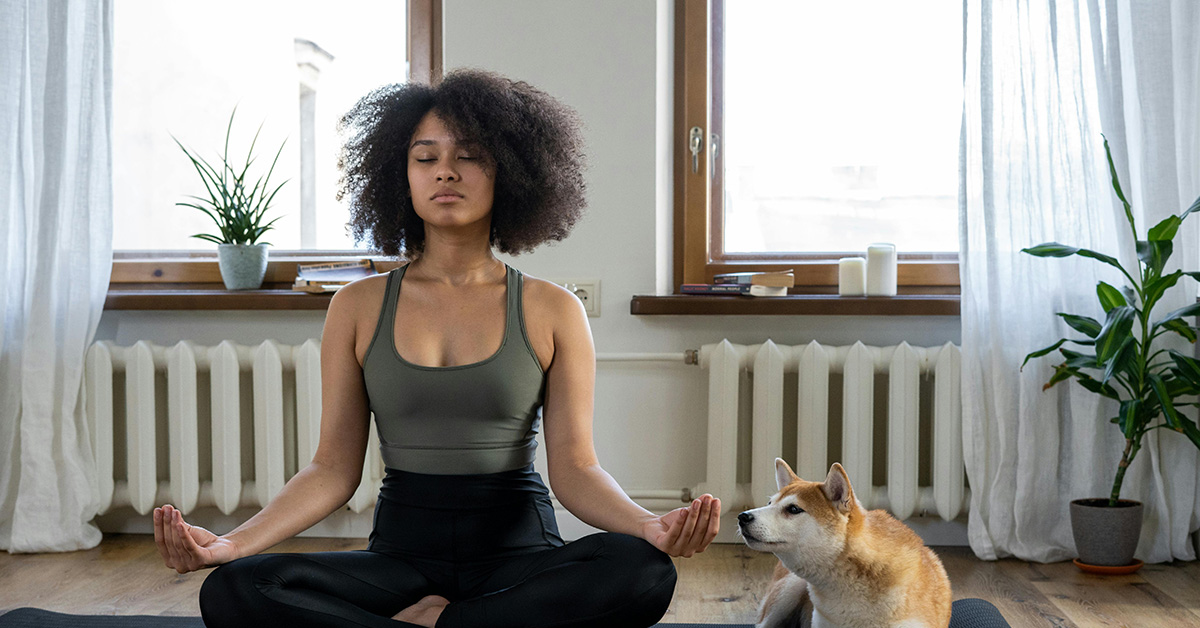Sitting around for 10 or 20 minutes making the “hummm” sound with your eyes closed is what many people think meditation is. That’s not quite it. Even if you don’t, at first glance, meditation may seem silly. However, it has many benefits that can help you melt away stress. It is a powerful tool for your well-being.
Our meditation for beginners guide will provide a new perspective. We’ll get to where it originated (briefly), why it’s important for your mental health, and how to do it. By the time you’re done reading our guide, you’ll know how to take a 10-minute vacation at work every single day. Let’s get to it!
Origins of Meditation
Where did meditation originate? Meditation has ancient roots across various cultures and religions. It originated over 5,000 years ago in ancient India, where it was integral to Hindu traditions. The earliest records of meditation are found in the Vedas, ancient Hindu scriptures dating back to 1500 BCE.
Meditation practices were also developed in China around 500 BCE. Taoist sages emphasized inner peace and harmony with nature. In Buddhism, meditation became central for achieving enlightenment. Siddhartha Gautama (the Buddha) taught mindfulness and concentration techniques.
The practice spread along trade routes, reaching Tibet, Southeast Asia, and later Japan. In the Land of the Rising Sun, Zen Buddhism further developed meditation techniques.
In the West, meditation gained prominence in the 20th century. It was influenced by Eastern philosophy and the mindfulness movement.
How Your Brains Works
Your brain has two modes of thinking: focus and diffused mode. Let me explain:
Focus mode: This is a concentrated, highly attentive state of mind where we apply deliberate effort to think through problems or tasks. In this mode, your brain is actively engaged.
Diffused mode: This is a relaxed, open, and often subconscious state of mind, allowing for more creative and holistic thinking. With this train of thought, you are practicing relaxed awareness.
Throughout your day, it’s likely that you spend plenty of time in focus mode. When you spend too much time in focus mode, you will inevitably reach burnout. No one wants to be there. And no one can afford to be there. However, if you don’t schedule a break or two throughout the day—your body and mind will do it for you. And it’s always at an inconvenient time. Also, that break will go on for longer than you’d like.
What’s one of the best ways to enter diffuse mode? Meditation.
Yes, working out, listening to music, and going for a walk are all great ways to enter diffused mode. However, meditation is the most convenient and easy way to get there.
Science-Backed Benefits of Meditation
Need some concrete evidence on why you should at least give meditation at try? No problem! Here are science-backed benefits of meditation:
- Reduces stress: Meditation can lower levels of cortisol, the stress hormone, and help reduce overall stress.
- Improved emotional well-being: It has been associated with reductions in symptoms of depression and anxiety.
- Enhanced focus and attention: Meditation practices can improve attention span, focus, and cognitive performance.
- Better sleep: Meditation can help improve sleep quality by promoting relaxation and reducing insomnia symptoms.
- Lower blood pressure: Meditation has been found to help reduce blood pressure, likely due to its stress-reducing effects.
- Increased self-awareness: Practices like mindfulness can increase self-awareness and help individuals develop a better understanding of their thoughts and behaviors.
- Improved memory: Some studies suggest that meditation can enhance working memory and cognitive function.
For a comprehensive look on how meditation and mindfulness can benefit you, check out this report in the National Library of Medicine.
How to Meditate for Beginners
There are only four things you need to do to meditate. Sure, there are other more complex ways to do this—but we’re keeping it simple here, as it’s your first time.
- Close your eyes
- Find an anchor point to focus on (example: your breath)
- Welcome any sensations in the body—don’t analyze, just breathe through it
- Redirect yourself to that anchor point every time your mind wanders (and it will wander!)
The more consistently you meditate, the better you get at staying in the present. You will realize that now is now. And you’ll learn to appreciate the present moment. Meditation is training your brain to notice the distracting or intrusive thoughts and gently shift focus to your breath or the present moment. In time, you’ll learn how to let go of thoughts easily.
Essential Meditation Tips for Beginners
Here are 3 essential meditation tips from our founder and CEO, Liesl Bernard, who has been practicing meditation for years:
Start Small and Build Gradually
I recommend starting your meditation practice with just a few minutes each day. Starting with just five minutes allows you to ease into the habit without feeling overwhelmed.
It was easier for me to gradually increase the duration as it became more of a consistent practice. This approach helps establish a consistent practice without the pressure of lengthy sessions.
Create a Consistent Routine
Meditating at the same time and place every day is easiest to make it a routine. This consistency helps reinforce the habit and makes it easier to integrate into your daily life.
Whether in the morning, during lunch, or before bed, find a time that works best for you and stick to it. This regularity can enhance your commitment to the practice.
Focus on Your Breath and Embrace Distractions
I recommend becoming conscious and aware of your breath as you start meditating. Don’t try to control it. Just observe the sensation of your breath entering and leaving your body.
If your mind wanders, which is normal, gently bring your focus back to your breath. Recognizing distractions as part of the process is crucial; each time you return to your breath, you strengthen your mindfulness practice.
Meditation Apps for Beginners
One of the most difficult things for beginners to do is meditate on their own. Which is perfectly normal. Sitting in silence trying to focus on your breath is challenging. Especially in a world that conditions you to move at 100mph as the standard.
Need help meditating? Start with guided meditations. Here are a few apps you can try out:
Here is a guided meditation video that beginners can follow:
Need Some Quick Meditation Tips for Beginners?
- Don’t make it a thing–keep it simple
- A quiet place is ideal but not necessary
- Start with a few minutes and then work your way up—5 minutes to start (can’t do 5? Try 3 minutes, can’t do 3? Try 30 seconds, etc.)
- Don’t judge yourself
- Say ‘in’ in your head when breathing in and ‘out’ in your head when breathing out if focusing on your breath is challenging
- View your wandering thoughts as just thoughts streaming by—and let them stream by

